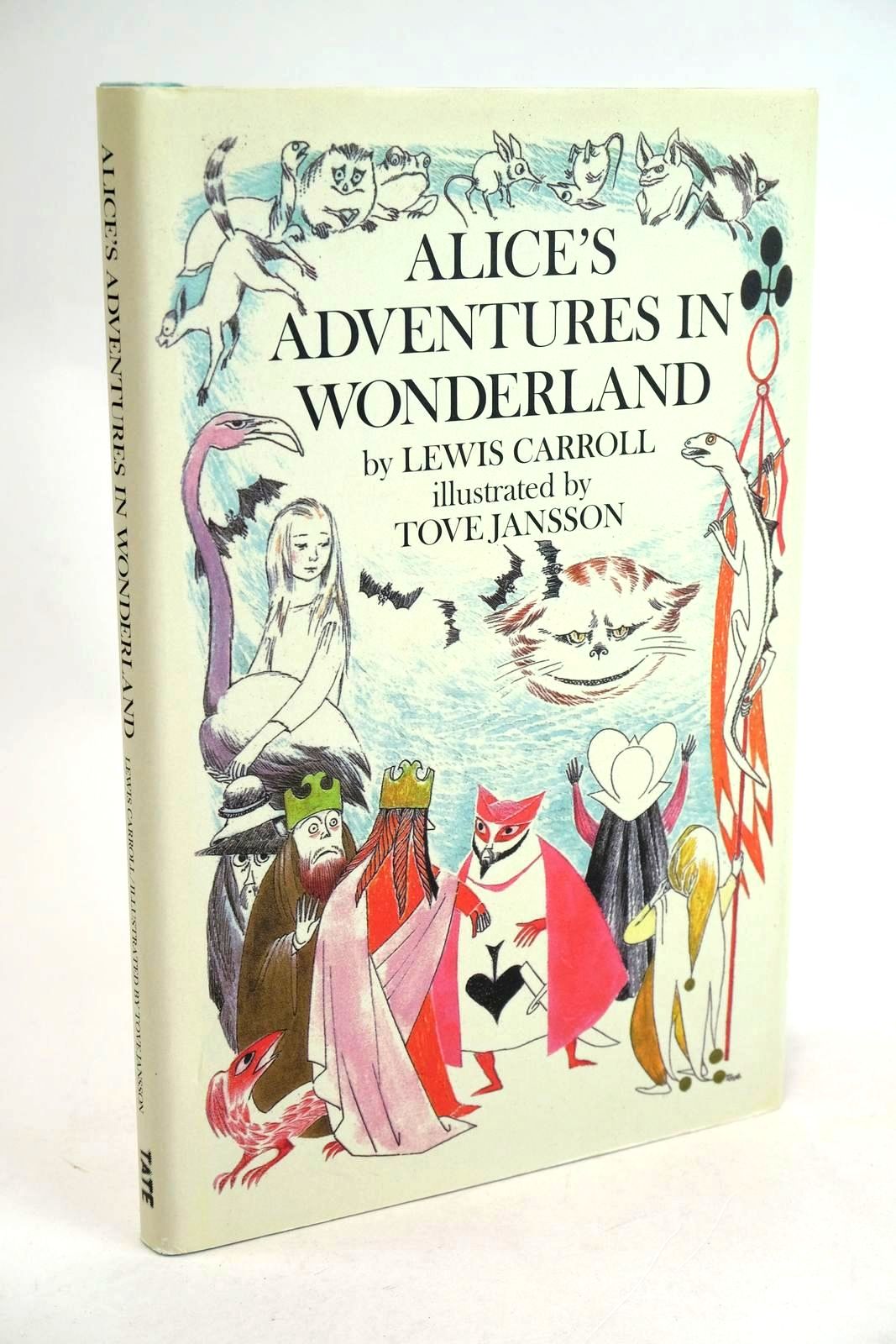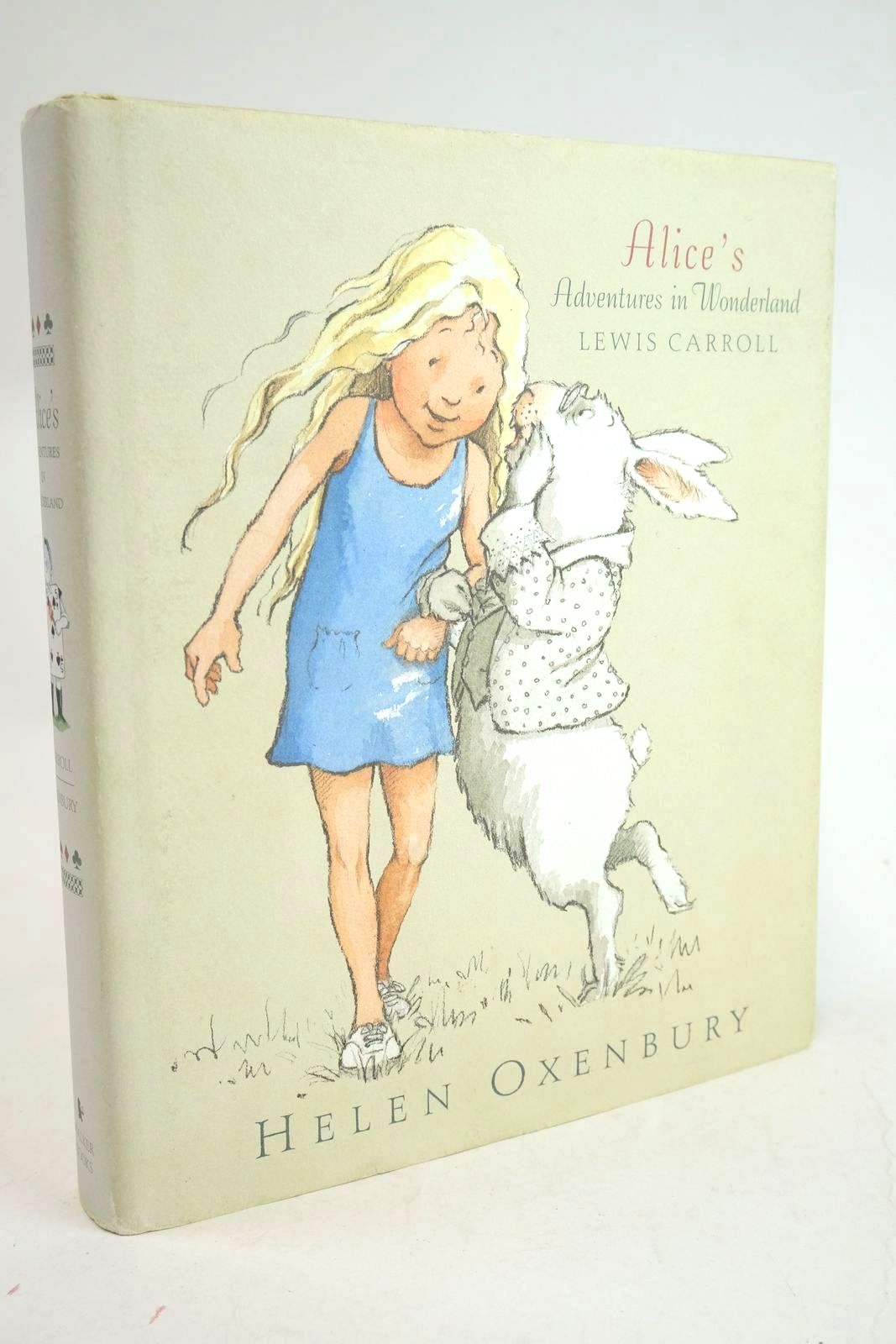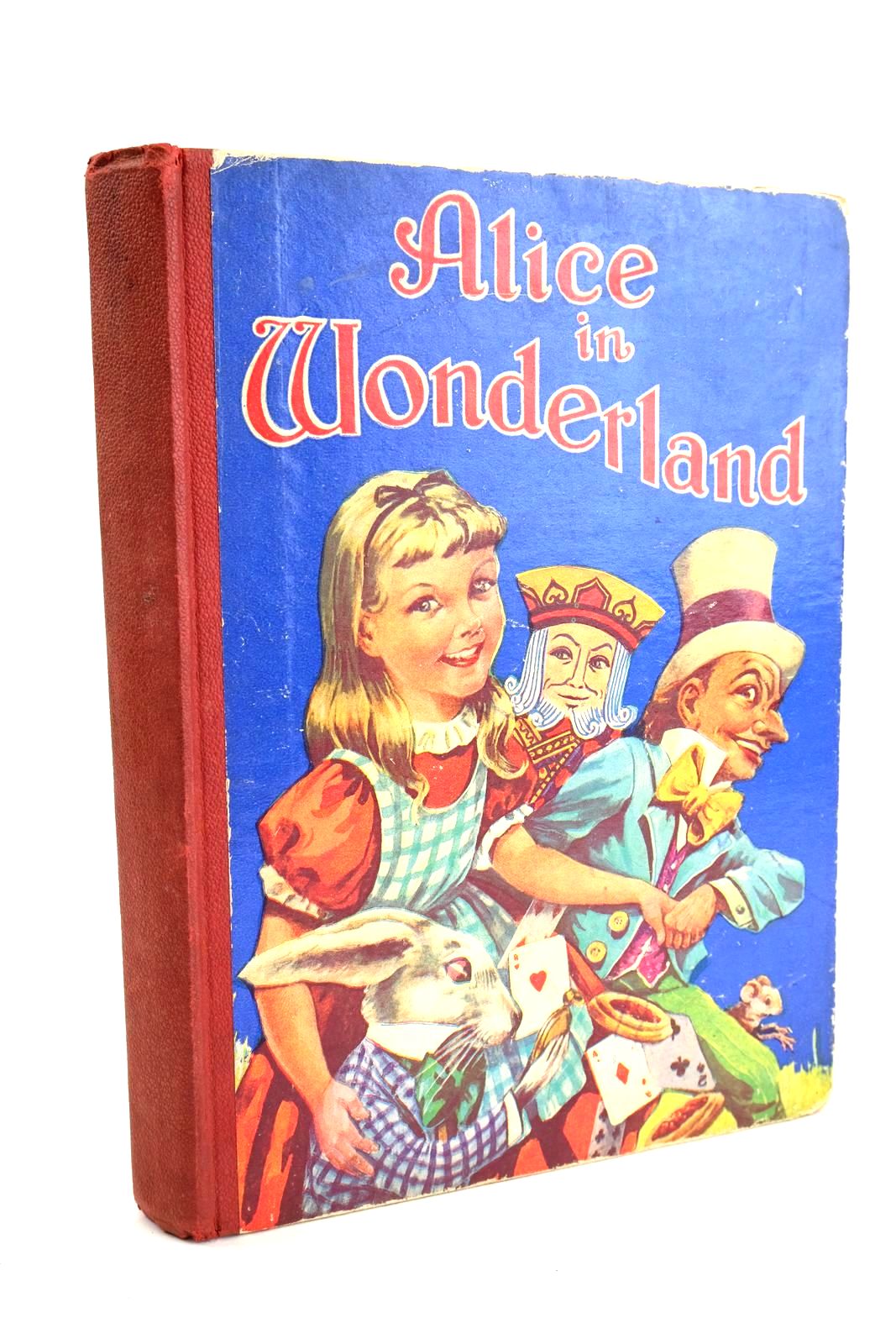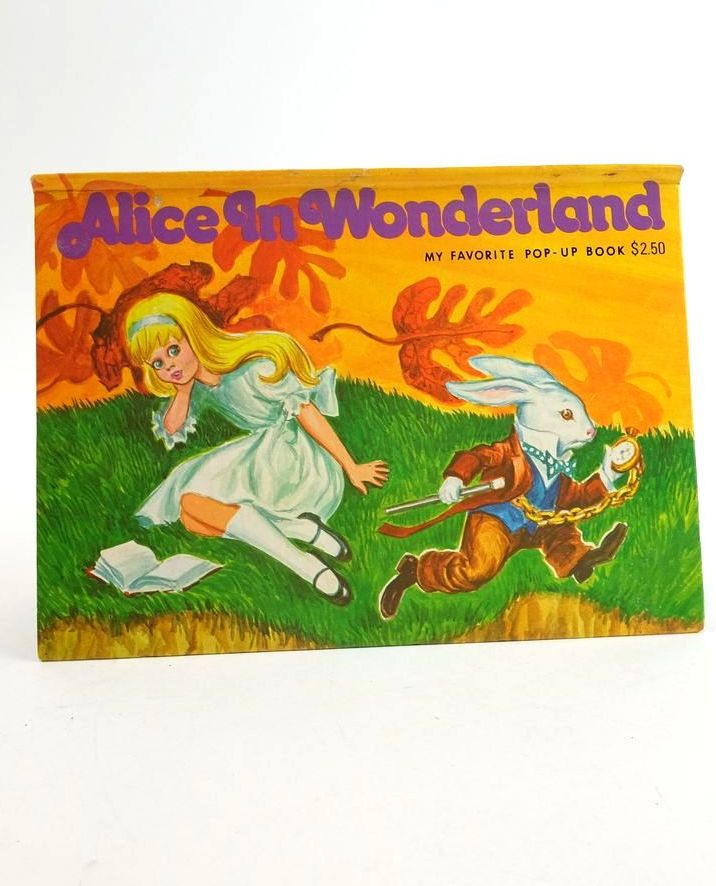Illustrators of Alice
Since Alice In Wonderland was first published in 1865, followed by Through The Looking-Glass and What Alice Saw There in 1871 (1st editions are dated 1872), hundreds of artists have illustrated these wonderful books with their fantastic characters. Many have depicted Alice in traditional style, while others have used their own style with these ranging from cute to outlandish. While not able to cover them all in the scope of this article, I hope to introduce you to a few which may be unfamiliar to you.
Most people, when thinking of Alice, will recall the images by John Tenniel, the artist many consider to be the greatest of the illustrators of Alice. Tenniel was the first to be published but the first to illustrate Alice was Carroll himself. His original manuscript contained many images of Alice but he was not convinced of his own artistic talent and so recruited Tenniel to illustrate the book for him. While the original Alice (Alice Liddell) had short dark hair, Carroll gave her long hair and Tenniel in turn gave her fair hair.
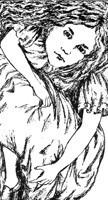
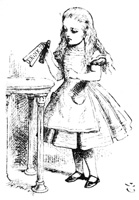
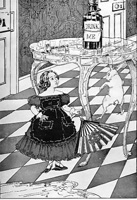
Above, from left: illustrations by Lewis Carroll, John Tenniel and Blanche McManus
Few artists attempted to recreate Alice while Carroll was alive. One who did was Blanche McManus who illustrated an American edition of Alice In Wonderland in 1896, depicting Alice with short darkish hair. This was a US pirate edition released without the authorised publisher's permission. In Ovenden's Illustrators of Alice In Wonderland, we learn that "there seems to be no comment from Carroll on these drawings which are pleasant but undistinguished".
After Carroll's death in 1898 other illustrated editions started to appear, first in the United States and then in Britain. But the floodgates really opened after the British copyright for Alice In Wonderland expired in 1907. In the year 1907 at least twelve editions were published after the copyright expired in November, and since that date hundreds of editions have been published.
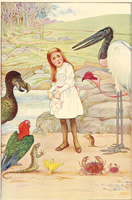
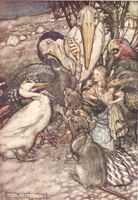
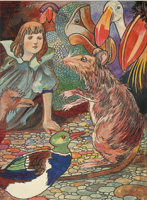
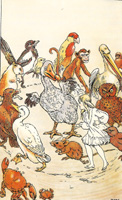
Above, from left: illustrations by Millicent Sowerby, Arthur Rackham, Charles Robinson and W.H. Walker
The first of these was by Millicent Sowerby whose illustrations are pretty but otherwise not inspiring. The next was by Thomas Maybank whose pictures are pleasant enough but again, not particularly memorable. These two were followed by the edition illustrated by Arthur Rackham and here was the first artist who could be compared with Tenniel. His Alice is more mature, delicate and beautiful with blushing cheeks, wearing a pretty white dress covered in pink roses. His pictures are haunting, not brightly coloured as others tended to be, but in dark, sombre tones of grey, green and brown. Not to everyone's taste but in typical Rackham style and in direct contrast to the pictures of other artists such as W.H. Walker and Charles Robinson, also published in 1907, who favoured bright and colourful illustrations. Charles Robinson, brother of William Heath and Thomas, was the only other artist in this period who developed his own style for illustrating Alice. His Alice is more like the original Alice Liddell with short dark hair and many of his black and white illustrations are bordered with elaborate decorations.
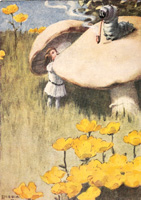
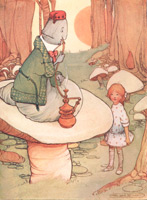
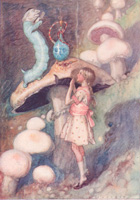
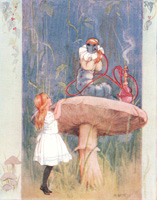
Above, from left: illustrations by Bessie Pease Gutmann, Mabel Lucie Attwell, A.E. Jackson and Margaret Tarrant.
From then on new editions of Alice appeared almost every year. It seemed that every book illustrator and artist had to have a go at Alice. Some created their own style Alice, others simply based theirs on Tenniel's illustrations. Those I've selected from the period 1908 to 1920 are Bessie Pease Gutmann (1908), Mabel Lucie Attwell (1911),A.E. Jackson (1915) and Margaret Tarrant (1916). Of these, Gutman, an American illustrator, is the only artist to portray Alice with dark hair. It is interesting also to note that both Jackson and Attwell show Alice in a very similar pink and white dress to that depicted by Rackham several years earlier. While Attwell has used her familiar cartoon style, thankfully her Alice is not as chubby as most of the Attwell children! She also manages to slip in a few elf-like characters, reminiscent of the Boo-Boos, here and there. Jackson 's pictures are very attractive in soft colours with a more up-to-date Alice having exchanged wrinkled stockings for white socks. Tarrant's Alice is also pretty but the illustrations are more simplistic with less detail.
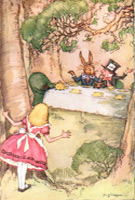
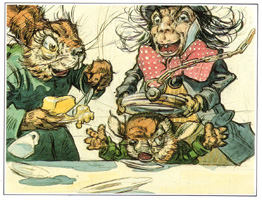
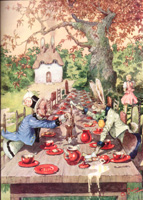
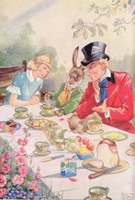
Above, from left: illustrations by A.H. Watson, David Hall, A. Rado and Rene Cloke.
The Mad Tea Party gives artists a superb opportunity to portray the wonderful characters of the Hatter, the March Hare and the Dormouse in their individual styles. Here are four examples: A.H. Watson (1939), David Hall (1939),Rene Cloke (1943) and A. Rado (1944). Hall's illustrations were made at the Walt Disney Studio in 1939, during the planning stages for an animated film of Alice In Wonderland. However, at that time the film was shelved and the pictures filed away in the Studio archives. When the film was eventually produced in 1948 Hall's pictures were not used and it was not until 1986 that these stunning pictures were published in book form by Methuen for us all to enjoy.
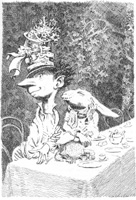
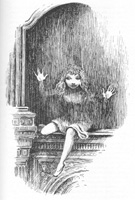
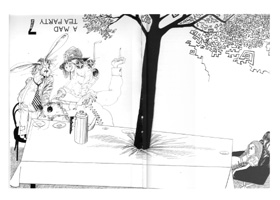
Above: two illustrations by Mervyn Peake (left), and one by Ralph Steadman (right).
Two of the most striking portrayals of Alice must be those of Mervyn Peake (1946) and Ralph Steadman (1967), shown above. Peake took two years to complete his drawings and was determined to rid himself of preconceived forms and to visualize the pageant of Lewis Carroll's creations through his own eyes. The result is fascinating and has a dream-like quality entirely consistent with the world of Alice. At the other end of the scale are the intriguing and sometimes rather frightening drawings of Ralph Steadman, whose book received avid critical acclaim and, in 1972, won an award for the best illustrated book of the previous five years. As you would expect of Steadman, Alice is no longer a pretty little girl, but a rather plain child with hair flying everywhere; the White Rabbit has a manic expression, "Today's commuter" explains Steadman; the Hatter represents the "unpleasant sides of Human nature"; the March Hare is the "Egger-on" and the Dormouse is "harmless and nice".
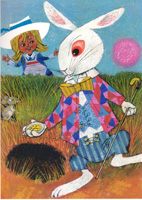
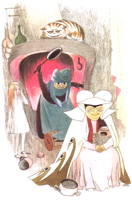
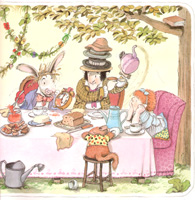
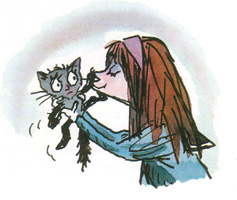

Above, from left: illustrations by Moritz Kennel, Tove Jansson, Francesc Rovira, Tony Ross and Helen Oxenbury.
Among other very original interpretations are those of Moritz Kennel (1975) and Tove Jansson (1966). Kennel gives all of Carroll's characters new life in modern drawings using vibrant colours. Jansson, best-known for her picture books about the Finn Family Moomintroll, has brought Alice to life with wit and imagination, a perfect match for the humour and enchantment of life at the end of the rabbit hole.
Last but not least I have included some modern favourites of mine - Francesc Rovira (1989), Tony Ross (1992) and Helen Oxenbury (1999). I love the expression on the face of Rovira's Alice - always cheeky, sometimes bored, typical of today's small child. Helen Oxenbury says that her mother read Alice to her as a child and she wanted to make it accessible for today's children. In this she is successful, Alice is a delightful little girl and all the characters are depicted with warmth and humour. And humour is the trademark of the Alice of Tony Ross - extraordinary and colourful illustrations which bring a smile to whoever turns the pages.
I hope you have enjoyed reading this article as much as I have enjoyed researching it.
Contributed by Chris Tomaszewski
Information gleaned from: The Illustrators of Alice In Wonderland by Graham Ovenden and John Davis, and from books in my own collection. Thanks also to Mr. E. Wakeling for amendments and additional facts.
(Published on 5th Nov 2013 )


